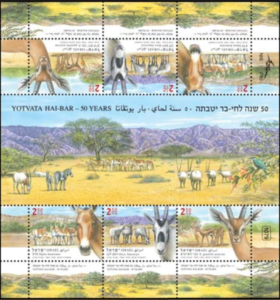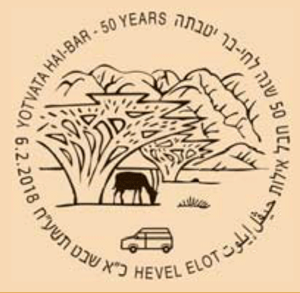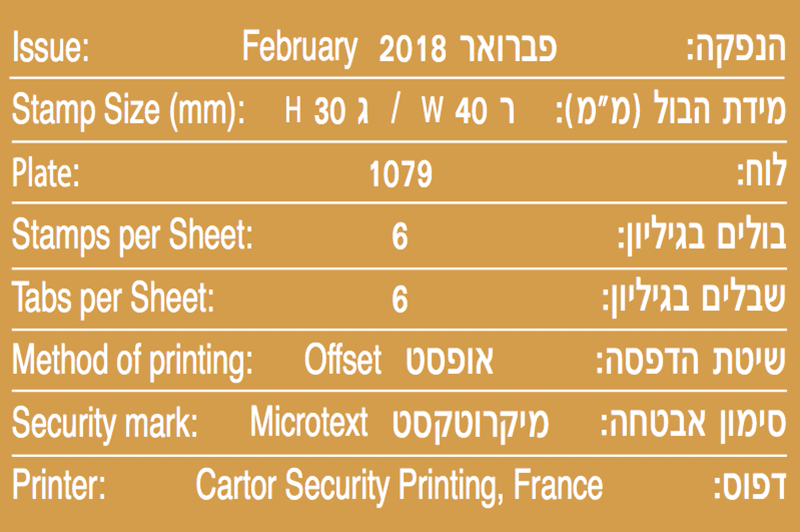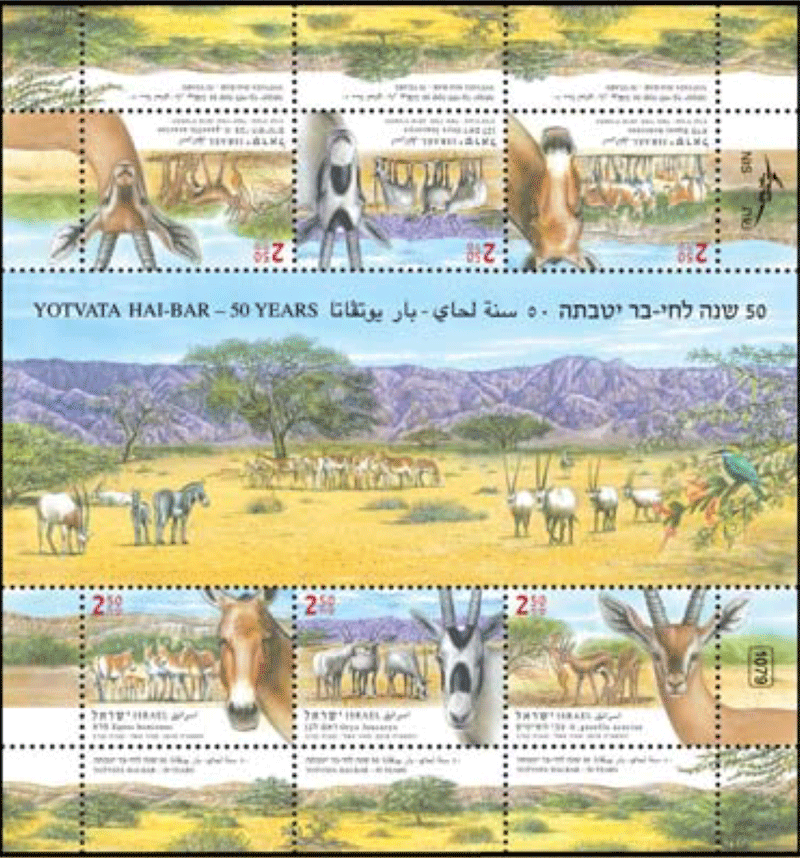These stamps will be issued February 6. From Israel Post:
Yotvata Hai-Bar – 50 Years
[A larger version of the minisheet is at the bottom of this page]
 A public association called Hai-Bar was founded in the 1960’s under the patronage of the Nature Parks Authority and managed by Avraham Yaffe and Uri Tson. The association’s objective was to restore wildlife species which had become extinct in Israel and repopulate endangered species. In the early 1970’s, an area of approximately 12,000 dunams (2965 acres) was fenced in within the Yotvata Nature Reserve, which preserves one of the salt flats in the Southern Arava. Large herbivores which had become extinct in Israel were brought in, as well as a number of species that did not exist in Israel but were endangered in the world, such as the wild ass, the white antelope, the Sahara oryx, the Arabian oryx , the African wild ass and the ostrich. It is a diverse habitat, rich in species and large acacia trees which grow in the western part of the reserve.
A public association called Hai-Bar was founded in the 1960’s under the patronage of the Nature Parks Authority and managed by Avraham Yaffe and Uri Tson. The association’s objective was to restore wildlife species which had become extinct in Israel and repopulate endangered species. In the early 1970’s, an area of approximately 12,000 dunams (2965 acres) was fenced in within the Yotvata Nature Reserve, which preserves one of the salt flats in the Southern Arava. Large herbivores which had become extinct in Israel were brought in, as well as a number of species that did not exist in Israel but were endangered in the world, such as the wild ass, the white antelope, the Sahara oryx, the Arabian oryx , the African wild ass and the ostrich. It is a diverse habitat, rich in species and large acacia trees which grow in the western part of the reserve.
In the beginning of the 21st century a few thousand additional dunams were fenced in to the west of highway 90 in order to protect the world’s last population of Acacia Gazelle, which is endangered worldwide. This species is monitored carefully to preserve its existence.
 Some of the wildlife species in Yotvata Hai-Bar are not being repopulated in Israel but are raised as part of an international preservation effort to prevent their extinction. The Hai-Bar also serves as an emergency veterinary facility as well as a rehabilitation and way station for animals injured in the wild, with the intention of releasing them back into nature once they’ve healed.
Some of the wildlife species in Yotvata Hai-Bar are not being repopulated in Israel but are raised as part of an international preservation effort to prevent their extinction. The Hai-Bar also serves as an emergency veterinary facility as well as a rehabilitation and way station for animals injured in the wild, with the intention of releasing them back into nature once they’ve healed.
Some of the Hai-Bar’s most prominent species:
The Arabian Oryx (Oryx leucoryx)
The Arabian oryx is suited to extreme desert conditions. It can survive for many days without water, making do with only the liquids derived from its food. It lives in small herds with a hierarchy for males and for females. The size of the herd varies depending on the food supply. Acacia seed pods are the Arabian oryx’s main source of food and passage through the oryx’s digestive system improves the seeds’ germination success. In the late 1970’s a breeding core with four pairs of oryx was established at the Hai-Bar, and today there are more than 100 of these animals in the reserve. An estimated 100 others live in the wild in the Arava and in the Negev mountain area.
Wild Ass (Equus hemionus)
The Wild Ass lives in herds of females that move between the territories of the dominant males, while the young males live in bachelor herds. It feeds on desert vegetation but does need water. The number of male territories is determined by the available water sources. The Asian wild ass, a sub-species of the Middle-eastern wild ass is extinct, thus the breeding core established in Yotvata Hai-Bar in the 1960’s was based on a population made up of two other sub-species: the Persian wild ass and the Turkmenian wild ass. The re-introduction program began in 1982 in the Machtesh Ramon area and is considered to be a success. Today there are some 300 of these animals living in the wild.
Acacia Gazelle (G. gazella acacia)
The Acacia Gazelle was discovered in the Arava in the 1960’s by zoologist Giora Ilani. This is the rarest gazelle species in Israel and the population is only about 20 animals, which currently live in a fenced area of the Yotvata Reserve. Most of its food comes from the acacia trees, mainly the foliage and the fruit, which it can reach by standing on its hind legs. The Israel Nature and Parks Authority makes great efforts to preserve and nurture the Acacia Gazelle population in the hope that in the future it will grow and be able to return to the wild.
—Tal Polak, PhD
Ecologist, Arava region
The Israel Nature and Parks Authority 




